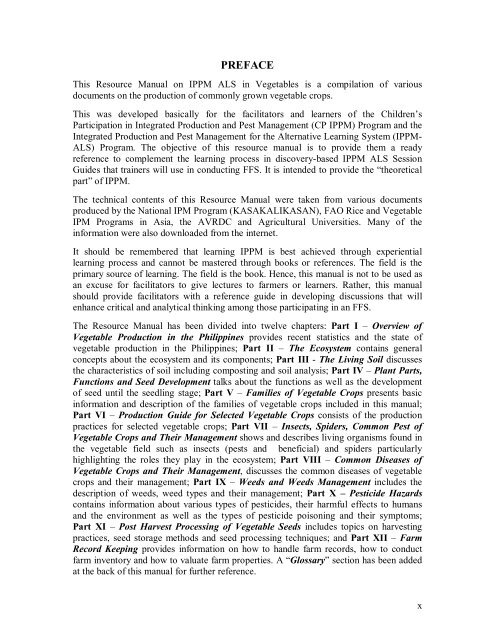(IPPM) in Vegetables - Vegetableipmasia.org
(IPPM) in Vegetables - Vegetableipmasia.org
(IPPM) in Vegetables - Vegetableipmasia.org
Create successful ePaper yourself
Turn your PDF publications into a flip-book with our unique Google optimized e-Paper software.
PREFACE<br />
This Resource Manual on <strong>IPPM</strong> ALS <strong>in</strong> <strong>Vegetables</strong> is a compilation of various<br />
documents on the production of commonly grown vegetable crops.<br />
This was developed basically for the facilitators and learners of the Childrens<br />
Participation <strong>in</strong> Integrated Production and Pest Management (CP <strong>IPPM</strong>) Program and the<br />
Integrated Production and Pest Management for the Alternative Learn<strong>in</strong>g System (<strong>IPPM</strong>-<br />
ALS) Program. The objective of this resource manual is to provide them a ready<br />
reference to complement the learn<strong>in</strong>g process <strong>in</strong> discovery-based <strong>IPPM</strong> ALS Session<br />
Guides that tra<strong>in</strong>ers will use <strong>in</strong> conduct<strong>in</strong>g FFS. It is <strong>in</strong>tended to provide the theoretical<br />
part of <strong>IPPM</strong>.<br />
The technical contents of this Resource Manual were taken from various documents<br />
produced by the National IPM Program (KASAKALIKASAN), FAO Rice and Vegetable<br />
IPM Programs <strong>in</strong> Asia, the AVRDC and Agricultural Universities. Many of the<br />
<strong>in</strong>formation were also downloaded from the <strong>in</strong>ternet.<br />
It should be remembered that learn<strong>in</strong>g <strong>IPPM</strong> is best achieved through experiential<br />
learn<strong>in</strong>g process and cannot be mastered through books or references. The field is the<br />
primary source of learn<strong>in</strong>g. The field is the book. Hence, this manual is not to be used as<br />
an excuse for facilitators to give lectures to farmers or learners. Rather, this manual<br />
should provide facilitators with a reference guide <strong>in</strong> develop<strong>in</strong>g discussions that will<br />
enhance critical and analytical th<strong>in</strong>k<strong>in</strong>g among those participat<strong>in</strong>g <strong>in</strong> an FFS.<br />
The Resource Manual has been divided <strong>in</strong>to twelve chapters: Part I Overview of<br />
Vegetable Production <strong>in</strong> the Philipp<strong>in</strong>es provides recent statistics and the state of<br />
vegetable production <strong>in</strong> the Philipp<strong>in</strong>es; Part II The Ecosystem conta<strong>in</strong>s general<br />
concepts about the ecosystem and its components; Part III - The Liv<strong>in</strong>g Soil discusses<br />
the characteristics of soil <strong>in</strong>clud<strong>in</strong>g compost<strong>in</strong>g and soil analysis; Part IV Plant Parts,<br />
Functions and Seed Development talks about the functions as well as the development<br />
of seed until the seedl<strong>in</strong>g stage; Part V Families of Vegetable Crops presents basic<br />
<strong>in</strong>formation and description of the families of vegetable crops <strong>in</strong>cluded <strong>in</strong> this manual;<br />
Part VI Production Guide for Selected Vegetable Crops consists of the production<br />
practices for selected vegetable crops; Part VII Insects, Spiders, Common Pest of<br />
Vegetable Crops and Their Management shows and describes liv<strong>in</strong>g <strong>org</strong>anisms found <strong>in</strong><br />
the vegetable field such as <strong>in</strong>sects (pests and beneficial) and spiders particularly<br />
highlight<strong>in</strong>g the roles they play <strong>in</strong> the ecosystem; Part VIII Common Diseases of<br />
Vegetable Crops and Their Management, discusses the common diseases of vegetable<br />
crops and their management; Part IX Weeds and Weeds Management <strong>in</strong>cludes the<br />
description of weeds, weed types and their management; Part X – Pesticide Hazards<br />
conta<strong>in</strong>s <strong>in</strong>formation about various types of pesticides, their harmful effects to humans<br />
and the environment as well as the types of pesticide poison<strong>in</strong>g and their symptoms;<br />
Part XI Post Harvest Process<strong>in</strong>g of Vegetable Seeds <strong>in</strong>cludes topics on harvest<strong>in</strong>g<br />
practices, seed storage methods and seed process<strong>in</strong>g techniques; and Part XII Farm<br />
Record Keep<strong>in</strong>g provides <strong>in</strong>formation on how to handle farm records, how to conduct<br />
farm <strong>in</strong>ventory and how to valuate farm properties. A Glossary section has been added<br />
at the back of this manual for further reference.<br />
x




![Section 4 [ PDF file, 252 KB] - The Field Alliance](https://img.yumpu.com/51387260/1/158x260/section-4-pdf-file-252-kb-the-field-alliance.jpg?quality=85)












